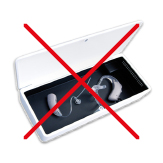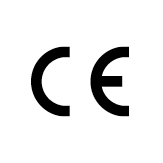
Know-How
Filter by category
The standard sizes of the hearing aid batteries are 10, 13, 312 and 675. They are colour-coded for easy identification, as follows:
- size 10: yellow
- size 13: orange
- size 312: brown
- size 675: blue
Hearing aid batteries use air as an energy source. The tab seals the air hole on the battery. Once the tab is removed, it takes approximately ten seconds before the hearing aid battery is activated and the battery compartment can be closed.
Please do not remove the tab before the hearing aid battery is used. Reattaching the tab will not prolong the service life of the battery.
Store your power one hearing aid batteries at between 10 and 30 degrees Celsius - preferably at room temperature between 20 - 25° C. Heat may shorten the service life, and a damp environment such as that of a fridge is not suitable for storage.
Moreover, never carry individual hearing aid batteries loose in your purse, wallet or handbag - contact with metal objects such as keys or coins can cause the hearing aid battery to short-circuit.
Please make sure you protect the battery air hole from moisture. Switching off your hearing aid when not in use can also prolong the life of the button cell.
The life of the hearing aid battery depends on the amount of use per day, the amplification and the type of hearing aid used.
Like all other batteries, hearing aid batteries must never be disposed of with the household waste or by incinerating.
Please dispose of the battery in an ecologically responsible manner - at recycling points, e.g. in supermarkets, or through your hearing aid audiologist.
No. The quality and construction of the electrode are the determining factors.
- A deformed battery is causing too weak a contact in the hearing aid
- A very rare case: the hearing aid battery is empty, even though it is new
- Dirt in the battery compartment of the hearing aid is disrupting the contact
- The hearing aid battery does not fit in the battery apparatus
A hearing aid battery can leak if it is deep drained. This can happen if the discharged battery is left in the hearing aid.
A hearing aid battery may expand if the discharged battery is left in the hearing aid and as a result is deep drained. It may also expand due to extremely high humidity.
Statistics show that, in the rarest of cases, the reasons for a short service life are not necessarily production faults, but rather:
- Environmental influences (e.g. humidity, temperature).
- Personal hearing habits have changed (longer period of use per day, higher noise level, new features of the hearing aid are being used).
- The hearing aid was in use longer than usual, e.g. at a long film evening.
- The hearing aid is new, or the type or brand of the hearing aid has changed.
- The new hearing aid has additional features that require more energy.
Improper handling can also reduce the service life of the hearing aid battery, e.g.:
- The battery is left for a long time without its tab before it is inserted in the hearing aid.
- The hearing aid is not switched off over night or after a long period of non-use.
- The battery loses capacity due to a short circuit when mishandled (e.g. through contact with metal objects).
- The battery is stored in a warm environment, e.g. in a car standing in the blazing sun.
Standard battery testers test the battery voltage and not the charging status. Batteries that were not yet activated, i.e. the tab was not pulled or only very recently, do not reach the nominal voltage of 1.4. In this case, the battery tester might show that the battery is “empty”. You can still use the battery for your hearing aid. It is fully charged and ready for use as the voltage is not the same as its power capacity. The battery’s nominal voltage of 1.4 V is only reached after some time. This means that the tester only shows that the battery is “full” later on. Battery testers are not suitable for checking the battery’s charging status. In fact, there is no tester on the market for measuring the capacity of zinc-air batteries as the measurement requires completely discharging the battery since capacity = power x time.
Also, many testers are highly inaccurate. These factors mean that a tester can only differentiate between a completely discharged battery and a partially discharged battery. Any statement on the actual remaining operating time of the hearing aid cannot be made this way.
We recommend buying the power one batteries from your hearing aid specialist.

Children
Always keep your hearing aid and batteries out of the reach of children, so that nothing can be swallowed or damaged. If such an accident should occur, you should seek emergency medical help immediately.

Do not short-circuit
Please avoid bringing an activated battery into contact with metallic objects, as this could cause them to drain or short-circuit.

Fire
Do not dispose of the battery in fire.

Do not recharge
VARTA zinc/air hearing aid batteries are non-rechargeable batteries and must therefore not be recharged.

Remove tab
Please remove tab immediately before use.

Temperature
Indicates the temperature limits at which VARTA zinc/air hearing aid batteries can be safely exposed (10°C to 30°C).

Storage
If you are not using your hearing aid, you would do well to store it in the drying set. Always transport it in its pouch. Switch it off to protect the battery. If you do not use it over a longer period, remove the batteries so that they do not undergo deep draining and leak into the hearing aid. Please bear in mind, however, that already activated batteries, whose strips of protective film have been removed, will drain faster. Regrettably, reattaching the protective film will have no effect.
Never carry individual hearing aid batteries loose in your purse or wallet - contact with metal objects such as keys or coins can cause the battery to short-circuit.

Loose bulk
Do not collect batteries loose in a container such as glass. Tip: Cover the cells with an adhesive strip.

SOS
After swallowing a cell, please contact a doctor.

Hourglass
Indicates the date after which VARTA zinc/air hearing aid batteries may no longer be used.

Manufacturer
VARTA Microbattery GmbH
VARTA-Platz 1
73479 Ellwangen
Germany
Tel: (+49) 7961 9210
Fax: (+49) 7961 921 2553

LOT
Displays the batch name of the VARTA zinc/air hearing aid batteries so that the batch or lot can be identified.

CE
Labeling for product manufacturing according to EU regulation.

MD + Application
Reference to a medical device with scope of application.

Trash can
Separate collection (See Disposal)

A used hearing aid battery should never remain in the hearing aid longer than necessary. Please support our efforts to protect the environment and do not throw a used battery away with the household waste. Please dispose of it in an ecologically responsible manner - for example, by depositing it in the recycling container at your audiologist's or supermarket. Like all batteries, hearing aid batteries must never be set on fire or incinerated.